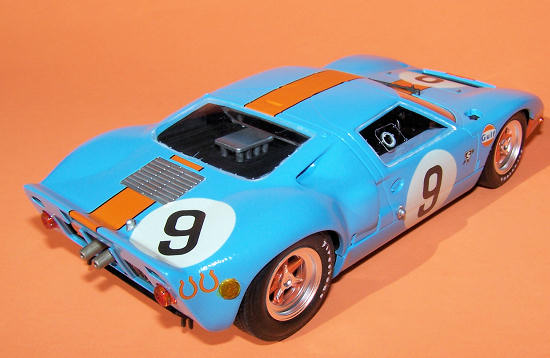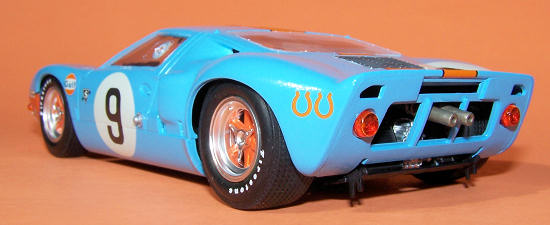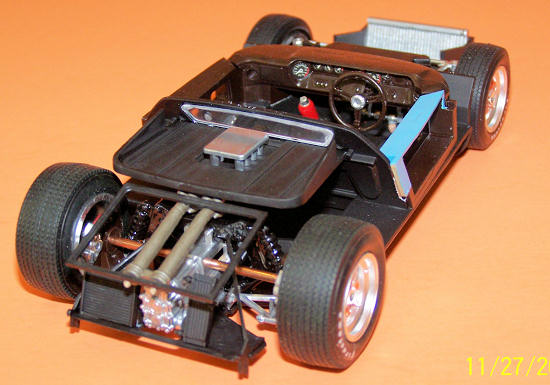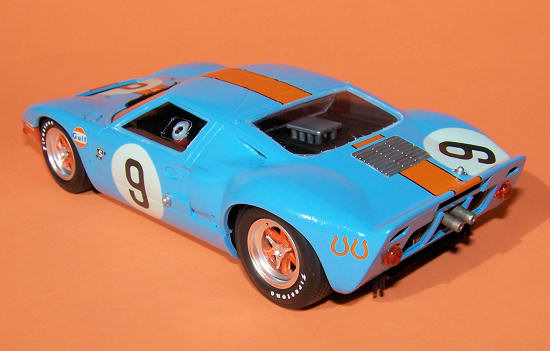Fujimi 1/24 Ford GT-40 Mk I (P1075)
|
KIT #: |
12131 |
|
PRICE: |
$34.00
|
|
DECALS: |
Three options |
|
REVIEWER: |
Sam Thurman |
|
NOTES: |
“Curbside” model
with some silver-plated parts |

In 1963 Ford Motor Company
launched an ambitious and expensive effort to develop a prototype racing car
capable of winning the World Sports Car Championship, creating the GT40, a car
that ultimately won the most famous endurance race, the 24 Hours of Le Mans, for
four consecutive years between 1966 and 1969. The effort was spawned after a
failed attempt by Ford to buy the Ferrari Company as a quick means of enhancing
its sporting credentials. Henry Ford II, head of the company and a direct
descent of its founder, commanded a team of his top lieutenants to beat “those
fast, little red cars” from Ferrari that had dominated
 European
sports car racing in the early 1960’s. There were several variants of the GT40
that were built, with the primary examples being the Mk I, Mk IIA/B, and Mk IV.
The Mk I, as run by Ford in 1964/65, was not that successful in winning races
but showed great potential that was realized with the development of its Mk II
and Mk IV successors, which won the WSCC in 1966 for Ford (the only time ever
for an American manufacturer) and the 24 Hours of Le Mans in both 1966 and 1967.
European
sports car racing in the early 1960’s. There were several variants of the GT40
that were built, with the primary examples being the Mk I, Mk IIA/B, and Mk IV.
The Mk I, as run by Ford in 1964/65, was not that successful in winning races
but showed great potential that was realized with the development of its Mk II
and Mk IV successors, which won the WSCC in 1966 for Ford (the only time ever
for an American manufacturer) and the 24 Hours of Le Mans in both 1966 and 1967.
Following its
1967 Le Mans victory, Ford withdrew from WSCC racing after a last-minute rules
change by the WSCC’s sanctioning body banning fast, powerful cars like the GT40
Mk IV starting in 1968. The new rules
limited prototypes to 3.0 liter engines (versus 7.0 liters in the Mk II/IV), but
created a temporary class for cars with 5.0 liter engines of which 50 (later
reduced to 25) examples had been built. This new class was intended to allow
cars like the GT40 Mk I, with its 4.8 liter engine, to be run as a way of
filling race grids until the manufacturers could develop new 3.0 liter cars. For
1968, a British team run by John Wyer, with backing from Gulf Oil, developed an
improved version of the older Mk I GT40 using their stock of GT40 chassis and
parts obtained from Ford through the sale of Ford Advanced Vehicles, the company
headed by Wyer that had developed the original car before Ford moved in to run
their 1966/67 racing programs with American-based teams. With their iconic blue
and orange livery, the Wyer Gulf GT40’s were the surprise championship winners
in 1968 against a formidable effort from Porsche with its new 3.0 liter
prototype. In 1969, the seemingly obsolete Wyer GT40 won the 24 Hours of Le Mans
in the closest finish in the entire 78 year history of the race, edging a
Porsche 908 prototype by less than 1.5 seconds.
This kit, one of
several Fujimi 1/24 kits of GT40 variants, portrays the improved Mk I version of
the car as run by the Wyer team in 1968. Relative to the original 1964 Mk I,
Wyer’s engineering group made several modifications to body, drivetrain and
chassis, increasing the displacement of the original Mk I engine to 5.0 liters
and improving its power output, while reducing the car’s weight to make it more
competitive with its newer prototype rivals. The car’s fenders were widened to
make room for wider, improved Firestone tires. Fujimi’s rendering of the car
comes with several parts in the box that are not used for this particular
version; it appears that one set of parts was made with the instructions
providing specifics on how the available p arts
are to be used for the intended GT40 variant.
arts
are to be used for the intended GT40 variant.
In the kit there
are about 120 plastic parts, molded in somewhat peculiar colors of light green,
for the major body pieces and smaller exterior pieces, and light brown, for the
underside, cockpit, suspension and transmission components. The molding of the
parts was good in most cases, with little in the way of flash or ejector pin
markings that needed filling. The clear parts for the windscreen windows, and
headlamp covers are very thin in some cases and must be handled carefully to
prevent damage. The wheels come with semi-gloss silver plating that provides a
fair match to their real-life aluminum counterparts. As a “curbside” model,
there are minimal chassis and engine compartment details included. The decal
sheet provides options for each of the three Gulf-liveried cars run by John
Wyer’s team at Le Mans in 1968. In addition to different numerals, each of these
cars had a distinctive pattern for the orange trim on their light-blue bodies so
that the team could tell them apart from one another when viewed at speed from
the pits or the signaling pit area at the end of Le Mans’ long (5.2 km) Mulsanne
straight. The instruction sheet comes in several languages, with minimal but
mostly adequate English annotations. The model isn’t complex so with careful
dry-fitting it wasn’t very difficult to figure out an acceptable fit and
assembly sequence from the instructions.
The kit’s
instructions begin with painting and assembly of the chassis and cockpit,
followed by the transmission, engine deck and rear suspension, and then finally
the exterior bodywork and all of the detailed pieces that are attached to it
(e.g., tail lamps, engine vent cover, fuel filler cap, etc.). I deviated from
the instructions to some extent, electing to construct and paint the
chassis/suspension roughly in parallel with bodywork, due to the amount of
effort involved in prepping, painting, and decals for body to obtain a good
finish on what is the most visible aspect of the model. In order to configure
the parts for the 1968 Gulf/Wyer variant of the GT40, some surgery is required
on the chassis and is detailed in the instructions. These modifications were
fairly simple and straightforward to accomplish with a couple of X-Acto knives.
 Assembly
and painting of the chassis, suspension and transmission were fairly
straightforward. Decals are provided for the instrument panel which looked
pretty good and were easily applied per the instructions. A separate and unusual
set of decals is provided for the tire labels which require considerable care to
apply successfully. These decals have a light adhesive on their front, so they
are applied by first gently rubbing them into place on the tire, and then they
need to be wetted and further pressure applied to get them to adhere well enough
to allow the paper backing to be removed without damage to the decal. Fujimi
provides 5 decals for the 4 tires, a good thing as I botched one of them and
needed the 5th decal. Considerable pressure is needed to get these
decals to adhere, so they are best applied prior to mounting the completed
tire/wheel assemblies onto the chassis. The bottom section of the car, holding
all of the chassis and transmission elements, is relatively large so I spray
painted it flat black, using brush-on enamels for the smaller parts needed for
the car’s interior, etc.
Assembly
and painting of the chassis, suspension and transmission were fairly
straightforward. Decals are provided for the instrument panel which looked
pretty good and were easily applied per the instructions. A separate and unusual
set of decals is provided for the tire labels which require considerable care to
apply successfully. These decals have a light adhesive on their front, so they
are applied by first gently rubbing them into place on the tire, and then they
need to be wetted and further pressure applied to get them to adhere well enough
to allow the paper backing to be removed without damage to the decal. Fujimi
provides 5 decals for the 4 tires, a good thing as I botched one of them and
needed the 5th decal. Considerable pressure is needed to get these
decals to adhere, so they are best applied prior to mounting the completed
tire/wheel assemblies onto the chassis. The bottom section of the car, holding
all of the chassis and transmission elements, is relatively large so I spray
painted it flat black, using brush-on enamels for the smaller parts needed for
the car’s interior, etc.
More than anything else with
this kit, I recommend fully assembling the body as a separate element before
gluing it onto the chassis, which can be accomplished after the
chassis/suspension is fully assembled and painted. The only step that must be
completed after the body is glued to the chassis, as indicated in the
instructions, is the attachment of the twin exhaust pipes which protrude outside
of the body on the finished model. The body work comes in two pieces, which can
be glued together early, allowing the body to be painted, decaled, and
clear-coated as a single assembly, after which the various clear pieces can be
glued into place. Particular care should be given to the assembly of the fog
lamps and their clear cover pieces, as the fit of the cover pieces is poor –
when the fog lamp and mounting base are assembled correctly, the cover pieces
won’t quite fit into place due to the protrusion of the fog lamp (I discovered
this the hard way). As the fog lamp lens and backing are glued into place, make
sure that the clear cover piece will in fact fit as intended!
 The
most distinctive aspect of the model’s appearance is the Gulf sponsorship color
scheme which consisted of a light, “powder” blue body color with a wide orange
racing strip and additional orange trim, depending upon the particular car and
race. While the decals included in the kit provide the orange stripes, if you
want your model to represent car no. 9, the 1968 Le Mans winner, you will need
to paint the “moustache” orange trim on the front of the car yourself to
complete its color scheme. After some searching I found no obvious readily
available colors that are perfect match for their original counterparts. After
some hobby shop consultation (thanks to the owner of House of Hobbies in
Burbank, CA!), I ended up using Testors “Light Blue” for the body, #1208 enamel
in a spray can and #1108 for bottled enamel, and a Testors Model Masters color
to match the orange stripe decals, called “Go Mango.” The Testors shade of blue
is slightly darker than the original, but when painted over a white base (I used
white Tamiya primer for plastics) it provides a nice, glossy finish that looks
pretty close to the proper color. The “Go Mango” enamel is also slightly darker
than the original car’s trim color – if using an airbrush or for the more
sophisticated modeler, with the addition of a little white to each of these
(blue and orange) colors a precise match to their original counterparts can be
achieved. Most of the car’s interior is painted flat black, with numerous silver
details to represent aluminum components of the actual car.
The
most distinctive aspect of the model’s appearance is the Gulf sponsorship color
scheme which consisted of a light, “powder” blue body color with a wide orange
racing strip and additional orange trim, depending upon the particular car and
race. While the decals included in the kit provide the orange stripes, if you
want your model to represent car no. 9, the 1968 Le Mans winner, you will need
to paint the “moustache” orange trim on the front of the car yourself to
complete its color scheme. After some searching I found no obvious readily
available colors that are perfect match for their original counterparts. After
some hobby shop consultation (thanks to the owner of House of Hobbies in
Burbank, CA!), I ended up using Testors “Light Blue” for the body, #1208 enamel
in a spray can and #1108 for bottled enamel, and a Testors Model Masters color
to match the orange stripe decals, called “Go Mango.” The Testors shade of blue
is slightly darker than the original, but when painted over a white base (I used
white Tamiya primer for plastics) it provides a nice, glossy finish that looks
pretty close to the proper color. The “Go Mango” enamel is also slightly darker
than the original car’s trim color – if using an airbrush or for the more
sophisticated modeler, with the addition of a little white to each of these
(blue and orange) colors a precise match to their original counterparts can be
achieved. Most of the car’s interior is painted flat black, with numerous silver
details to represent aluminum components of the actual car.
In several places the
instructions were either ambiguous about colors for certain details or seemingly
non-intuitive in their recommendations. Here are examples to be aware of: the
instructions show, correctly, that the wheel spokes should be painted orange,
but after examining photographs of the actual cars, it was evident that the
inner areas of the wheels near the spokes should be painted orange as well; the
recess ed
areas surrounding the headlamps should be painted flat black, as shown in photos
of the real cars, although the instructions don’t indicate this. To the
contrary, the recessed areas around the fog lamps should be painted orange or
blue, as appropriate for the particular car no. of interest. Something else to
be aware of is that the Gulf-Wyer GT40’s had no fuel filler cap on the left-hand
side of the car; in the kit a plastic part is provided with which to fill a
location in the body for such a filler cap, which did exist on the Mk II
versions of the car. This part should be glued in, then filler used to smooth
this over, in order to get the best match to the appearance of the actual cars
which had no filler cap in this location (doing the research on this was
something I unfortunately did after the model was nearly completed).
ed
areas surrounding the headlamps should be painted flat black, as shown in photos
of the real cars, although the instructions don’t indicate this. To the
contrary, the recessed areas around the fog lamps should be painted orange or
blue, as appropriate for the particular car no. of interest. Something else to
be aware of is that the Gulf-Wyer GT40’s had no fuel filler cap on the left-hand
side of the car; in the kit a plastic part is provided with which to fill a
location in the body for such a filler cap, which did exist on the Mk II
versions of the car. This part should be glued in, then filler used to smooth
this over, in order to get the best match to the appearance of the actual cars
which had no filler cap in this location (doing the research on this was
something I unfortunately did after the model was nearly completed).
The decals provided with the
kit were thin and of good quality. They went on pretty well and would conform to
the contours of the bodywork as long as a suitable decal softener is employed. A
note of caution is needed for the white roundels, though, which serve as backing
for the numbers. These had some noticeable transparency to them due to their
thinness, especially when applied over the orange stripe as required for the
front cowl.
 Overall
I was reasonably pleased with this model once finished. The parts, instructions,
and decals provided a good level of detail, for a curbside kit, with a degree of
difficulty that was within reach of my modest skills. I had wanted to find a
model of the GT40 as run by the Gulf-Wyer team and I believe this kit by Fujimi
is the only one made recently for those with such interests. The no. 9 version
of the car is more challenging than is cousins (no.’s 10 and 11) as the orange
“moustache” trim around the car’s front needs to be painted by the modeler to
fit with the supplied decal. Due to the painting requirements it’s not a quick
model to make, but aside from the handful of parts fit issues I encountered,
careful work can lead to a satisfying result of what is one of the most iconic
cars in the history of endurance racing!
Overall
I was reasonably pleased with this model once finished. The parts, instructions,
and decals provided a good level of detail, for a curbside kit, with a degree of
difficulty that was within reach of my modest skills. I had wanted to find a
model of the GT40 as run by the Gulf-Wyer team and I believe this kit by Fujimi
is the only one made recently for those with such interests. The no. 9 version
of the car is more challenging than is cousins (no.’s 10 and 11) as the orange
“moustache” trim around the car’s front needs to be painted by the modeler to
fit with the supplied decal. Due to the painting requirements it’s not a quick
model to make, but aside from the handful of parts fit issues I encountered,
careful work can lead to a satisfying result of what is one of the most iconic
cars in the history of endurance racing!
1.
Horsman, John,
Racing in the Rain (My Years with
Brilliant Drivers, Legendary Sports Cars, and a Dedicated Team). David Bull
Publishing, Phoenix, AZ, 2006.
2.
Allen, John S. and Gordon J.
Jones, The Ford that Beat Ferrari – A
Racing History of the GT40. Haynes Publishing North America, Inc., Newbury
Park CA, Jun. 2005.
3.
Baime, A. J.,
Go like Hell (Ford, Ferrari, and Their
Battle for Speed and Glory at Le Mans). Houghton Mifflin Harcourt Publishing
Company, New York, NY, 2009.
Sam Thurman
January 2012
If you would like your product reviewed fairly and fairly quickly, please contact the editor or see other details in the Note to
Contributors.
Back to the Main Page
Back to the Review
Index Page


 European
sports car racing in the early 1960’s. There were several variants of the GT40
that were built, with the primary examples being the Mk I, Mk IIA/B, and Mk IV.
The Mk I, as run by Ford in 1964/65, was not that successful in winning races
but showed great potential that was realized with the development of its Mk II
and Mk IV successors, which won the WSCC in 1966 for Ford (the only time ever
for an American manufacturer) and the 24 Hours of Le Mans in both 1966 and 1967.
European
sports car racing in the early 1960’s. There were several variants of the GT40
that were built, with the primary examples being the Mk I, Mk IIA/B, and Mk IV.
The Mk I, as run by Ford in 1964/65, was not that successful in winning races
but showed great potential that was realized with the development of its Mk II
and Mk IV successors, which won the WSCC in 1966 for Ford (the only time ever
for an American manufacturer) and the 24 Hours of Le Mans in both 1966 and 1967.  arts
are to be used for the intended GT40 variant.
arts
are to be used for the intended GT40 variant. Assembly
and painting of the chassis, suspension and transmission were fairly
straightforward. Decals are provided for the instrument panel which looked
pretty good and were easily applied per the instructions. A separate and unusual
set of decals is provided for the tire labels which require considerable care to
apply successfully. These decals have a light adhesive on their front, so they
are applied by first gently rubbing them into place on the tire, and then they
need to be wetted and further pressure applied to get them to adhere well enough
to allow the paper backing to be removed without damage to the decal. Fujimi
provides 5 decals for the 4 tires, a good thing as I botched one of them and
needed the 5th decal. Considerable pressure is needed to get these
decals to adhere, so they are best applied prior to mounting the completed
tire/wheel assemblies onto the chassis. The bottom section of the car, holding
all of the chassis and transmission elements, is relatively large so I spray
painted it flat black, using brush-on enamels for the smaller parts needed for
the car’s interior, etc.
Assembly
and painting of the chassis, suspension and transmission were fairly
straightforward. Decals are provided for the instrument panel which looked
pretty good and were easily applied per the instructions. A separate and unusual
set of decals is provided for the tire labels which require considerable care to
apply successfully. These decals have a light adhesive on their front, so they
are applied by first gently rubbing them into place on the tire, and then they
need to be wetted and further pressure applied to get them to adhere well enough
to allow the paper backing to be removed without damage to the decal. Fujimi
provides 5 decals for the 4 tires, a good thing as I botched one of them and
needed the 5th decal. Considerable pressure is needed to get these
decals to adhere, so they are best applied prior to mounting the completed
tire/wheel assemblies onto the chassis. The bottom section of the car, holding
all of the chassis and transmission elements, is relatively large so I spray
painted it flat black, using brush-on enamels for the smaller parts needed for
the car’s interior, etc.
 ed
areas surrounding the headlamps should be painted flat black, as shown in photos
of the real cars, although the instructions don’t indicate this. To the
contrary, the recessed areas around the fog lamps should be painted orange or
blue, as appropriate for the particular car no. of interest. Something else to
be aware of is that the Gulf-Wyer GT40’s had no fuel filler cap on the left-hand
side of the car; in the kit a plastic part is provided with which to fill a
location in the body for such a filler cap, which did exist on the Mk II
versions of the car. This part should be glued in, then filler used to smooth
this over, in order to get the best match to the appearance of the actual cars
which had no filler cap in this location (doing the research on this was
something I unfortunately did after the model was nearly completed).
ed
areas surrounding the headlamps should be painted flat black, as shown in photos
of the real cars, although the instructions don’t indicate this. To the
contrary, the recessed areas around the fog lamps should be painted orange or
blue, as appropriate for the particular car no. of interest. Something else to
be aware of is that the Gulf-Wyer GT40’s had no fuel filler cap on the left-hand
side of the car; in the kit a plastic part is provided with which to fill a
location in the body for such a filler cap, which did exist on the Mk II
versions of the car. This part should be glued in, then filler used to smooth
this over, in order to get the best match to the appearance of the actual cars
which had no filler cap in this location (doing the research on this was
something I unfortunately did after the model was nearly completed).